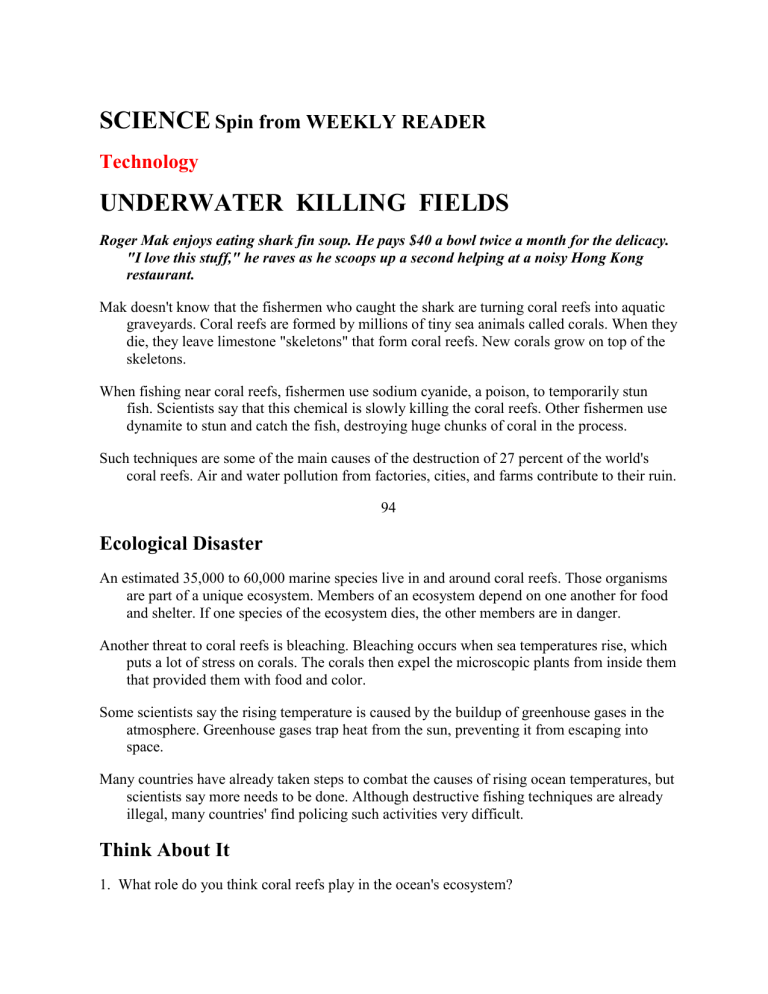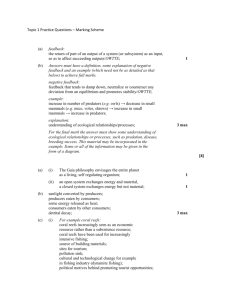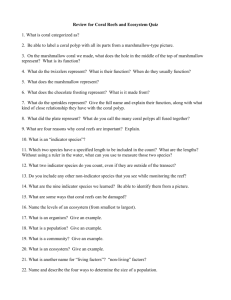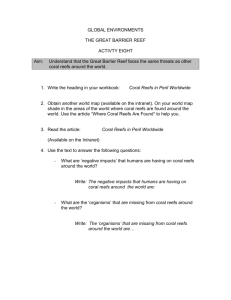SCIENCE Spin from WEEKLY READER Technology

SCIENCE
Spin from WEEKLY READER
Technology
UNDERWATER KILLING FIELDS
Roger Mak enjoys eating shark fin soup. He pays $40 a bowl twice a month for the delicacy.
"I love this stuff," he raves as he scoops up a second helping at a noisy Hong Kong restaurant.
Mak doesn't know that the fishermen who caught the shark are turning coral reefs into aquatic graveyards. Coral reefs are formed by millions of tiny sea animals called corals. When they die, they leave limestone "skeletons" that form coral reefs. New corals grow on top of the skeletons.
When fishing near coral reefs, fishermen use sodium cyanide, a poison, to temporarily stun fish. Scientists say that this chemical is slowly killing the coral reefs. Other fishermen use dynamite to stun and catch the fish, destroying huge chunks of coral in the process.
Such techniques are some of the main causes of the destruction of 27 percent of the world's coral reefs. Air and water pollution from factories, cities, and farms contribute to their ruin.
94
Ecological Disaster
An estimated 35,000 to 60,000 marine species live in and around coral reefs. Those organisms are part of a unique ecosystem. Members of an ecosystem depend on one another for food and shelter. If one species of the ecosystem dies, the other members are in danger.
Another threat to coral reefs is bleaching. Bleaching occurs when sea temperatures rise, which puts a lot of stress on corals. The corals then expel the microscopic plants from inside them that provided them with food and color.
Some scientists say the rising temperature is caused by the buildup of greenhouse gases in the atmosphere. Greenhouse gases trap heat from the sun, preventing it from escaping into space.
Many countries have already taken steps to combat the causes of rising ocean temperatures, but scientists say more needs to be done. Although destructive fishing techniques are already illegal, many countries' find policing such activities very difficult.
Think About It
1. What role do you think coral reefs play in the ocean's ecosystem?
2. How can satellites help scientists protect coral reefs?
A VIEW FROM ABOVE
Scientists study coral reefs by visiting specific sites or by studying detailed images taken by satellites, such as Landsat 7. The images 11 show where the reefs are found. Over time they can also show changes in reefs.
Using images, observations and data, scientists hypothesize that the planet's coral reefs might be destroyed in less than 20 years. "Like rain forests, reefs harbor much of the planet's wealth off species and are being rapidly degraded by humans," said Dirk Bryant, a scientist at the World Resources Institute.
95
SCIENCE
Spin from WEEKLY READER
People
Elephant Talk
Joyce Poole is not exactly Dr. Dolittle, but she swears that elephants can talk. She said the animals' squeals, screams, snorts, rumbles, and groans have special meanings—just like the words humans use.
Poole lives among about 1000 African savanna elephants in Kenya's Amboseli National Park.
The park is on Kenya's border with Tanzania and near Mount Kilimanjaro, Africa's highest peak.
Poole, a wildlife biologist, has discovered that elephants use more than 70 vocal sounds to communicate with other elephants. The sounds range from soft whispers to earsplitting roars.
According to Poole, elephants use their "voices" to warn others of danger, to form packs, to defend themselves, and to tell other elephants what they want.
Poole and other biologists have studied much more than how elephants "talk." They have found that the pachyderms also use 160 different types of touch, sight, and even chemical signals to interact with one another.
Career Ecologist
To help protect the ecosystem of an endangered animal, conservationists might turn to an ecologist. Ecologists study the relationships among organisms. They also study the relationship between the organisms and their environments. Ecologists look at such things as the impact of population size, pollutants, and rainfall.
96
SCIENCE Projects
for Home or School
You Can Do It!
Materials
3 paper towels
bowl with water
large cookie sheet
wax paper
paper clips
Quick and Easy Project
Desert Leaves
Procedure
1.
Wet each paper towel. Squeeze out some of the water so that it's not dripping.
2.
Place one towel flat on the cookie sheet.
3.
Roll up the second towel, and place it next to the flat towel.
4.
Roll up the third towel. Roll the wax paper around it, and paper-clip it in place. Place this roll next to the other roll.
5.
Place the cookie sheet in a sunny place. Wait 24 hours.
6.
Unroll the towels. Feel each towel to see if it is still damp.
Draw Conclusions
Which towel kept the most water? Which kept the least? Why? Use your results to explain how the structure of leaves of desert plants helps them conserve the desert's limited water.
Design Your Own Investigation
Do People Affect Ecosystems?
What effects do people have on ecosystems? Observe a part of an ecosystem where you live.
What are the human effects? Are any parts of the natural ecosystem still there? If not, what has replaced them? Design an investigation that will help you determine how to make observations and collect data to identify changes in an ecosystem. Compare your results with those of other students in your class.
97






